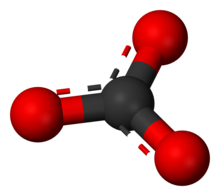Carbonate
 Carbonate anion
| |
 | |
 | |
| Names | |
|---|---|
| Preferred IUPAC name
Carbonate | |
| Systematic IUPAC name
Trioxidocarbonate[1]: 127 | |
| Identifiers | |
3D model (JSmol)
|
|
| ChemSpider | |
PubChemCID
|
|
| UNII | |
| |
| |
| Properties | |
| CO2−3 | |
| Molar mass | 60.008g·mol−1 |
| Conjugate acid | Bicarbonate |
Except where otherwise noted, data are given for materials in theirstandard state(at 25 °C [77 °F], 100 kPa).
| |
Acarbonateis asaltofcarbonic acid,H2CO3,[2]characterized by the presence of thecarbonate ion,apolyatomic ionwith the formulaCO2−3.The word "carbonate" may also refer to acarbonate ester,an organic compound containing thecarbonate groupO=C(−O−)2.
The term is also used as a verb, to describecarbonation:the process of raising the concentrations of carbonate andbicarbonateions in water to producecarbonated waterand other carbonated beverages – either by the addition ofcarbon dioxidegas under pressure or by dissolving carbonate or bicarbonate salts into the water.
Ingeologyandmineralogy,the term "carbonate" can refer both tocarbonate mineralsandcarbonate rock(which is made of chiefly carbonate minerals), and both are dominated by the carbonate ion,CO2−3.Carbonate minerals are extremely varied and ubiquitous in chemically precipitatedsedimentary rock.The most common arecalciteorcalcium carbonate,CaCO3,the chief constituent oflimestone(as well as the main component ofmolluscshells andcoralskeletons);dolomite,a calcium-magnesium carbonateCaMg(CO3)2;andsiderite,oriron(II) carbonate,FeCO3,an importantiron ore.Sodium carbonate( "soda" or "natron" ),Na2CO3,andpotassium carbonate( "potash" ),K2CO3,have been used since antiquity for cleaning and preservation, as well as for the manufacture ofglass.Carbonates are widely used in industry, such as in iron smelting, as a raw material forPortland cementandlimemanufacture, in the composition ofceramic glazes,and more. New applications of alkali metal carbonates include: thermal energy storage,[3][4]catalysis[5]and electrolyte both in fuel cell technology[6]as well as in electrosynthesis ofH2O2in aqueous media.[7]
Structure and bonding
[edit]The carbonate ion is the simplestoxocarbon anion.It consists of onecarbonatom surrounded by threeoxygenatoms, in atrigonal planararrangement, withD3hmolecular symmetry.It has a molecular mass of 60.01g/moland carries a totalformal chargeof −2. It is theconjugate baseof thehydrogencarbonate (bicarbonate)[8]ion,HCO−3,which is the conjugate base ofH2CO3,carbonic acid.
TheLewis structureof the carbonate ion has two (long) single bonds to negative oxygen atoms, and one short double bond to a neutral oxygen atom.
This structure is incompatible with the observed symmetry of the ion, which implies that the three bonds are the same length and that the three oxygen atoms are equivalent. As in the case of theisoelectronicnitrateion, the symmetry can be achieved by aresonanceamong three structures:
This resonance can be summarized by a model with fractional bonds anddelocalizedcharges:
Chemical properties
[edit]
Metal carbonates generally decompose on heating, liberating carbon dioxide leaving behind an oxide of the metal.[2]This process is calledcalcination,aftercalx,the Latin name of quicklime orcalcium oxide,CaO, which is obtained by roasting limestone in alime kiln:
- CaCO3→ CaO + CO2
As illustrated by its affinity forCa2+,carbonate is a ligand for many metal cations.Transition metal carbonate and bicarbonate complexesfeature metal ions covalently bonded to carbonate in a variety of bonding modes.
Lithium,sodium,potassium,rubidium,caesium,andammoniumcarbonates are water-soluble salts, but carbonates of 2+ and 3+ ions are often poorly soluble in water. Of the insoluble metal carbonates,CaCO3is important because, in the form ofscale,it accumulates in and impedes flow through pipes.Hard wateris rich in this material, giving rise to the need for infrastructuralwater softening.
Acidification of carbonates generally liberatescarbon dioxide:
- CaCO3+ 2 HCl → CaCl2+ CO2+ H2O
Thus, scale can be removed with acid.
In solution the equilibrium between carbonate, bicarbonate, carbon dioxide and carbonic acid is sensitive to pH, temperature, and pressure. Although di- and trivalent carbonates have low solubility, bicarbonate salts are far more soluble. This difference is related to the disparatelattice energiesof solids composed of mono- vs dianions, as well as mono- vs dications.
Inaqueous solution,carbonate, bicarbonate, carbon dioxide, and carbonic acid participate in adynamic equilibrium.In strongly basic conditions, the carbonate ion predominates, while in weakly basic conditions, thebicarbonateion is prevalent. In more acid conditions, aqueouscarbon dioxide,CO2(aq),is the main form, which, with water,H2O,is in equilibrium with carbonic acid – the equilibrium lies strongly towards carbon dioxide. Thussodium carbonateis basic,sodium bicarbonateis weakly basic, while carbon dioxide itself is a weak acid.
Organic carbonates
[edit]Inorganic chemistrya carbonate can also refer to afunctional groupwithin a larger molecule that contains a carbon atom bound to three oxygen atoms, one of which is double bonded. These compounds are also known as organocarbonates or carbonate esters, and have the general formulaR−O−C(=O)−O−R′,orRR′CO3.Important organocarbonates includedimethyl carbonate,the cyclic compoundsethylene carbonateandpropylene carbonate,and the phosgene replacement,triphosgene.
Buffer
[edit]Three reversible reactions control thepHbalance of blood and act as abufferto stabilise it in the range 7.37–7.43:[9][10]
- H++ HCO−3⇌ H2CO3
- H2CO3⇌ CO2(aq) + H2O
- CO2(aq) ⇌ CO2(g)
ExhaledCO2(g)depletesCO2(aq),which in turn consumesH2CO3,causing the equilibrium of the first reaction to try to restore the level of carbonic acid by reacting bicarbonate with a hydrogen ion, an example ofLe Châtelier's principle.The result is to make the blood more alkaline (raise pH). By the same principle, when the pH is too high, the kidneys excrete bicarbonate (HCO−3) into urine as urea via theurea cycle(or Krebs–Henseleit ornithine cycle). By removing the bicarbonate, moreH+is generated from carbonic acid (H2CO3), which comes fromCO2(g)produced bycellular respiration.[11]
Crucially, a similar buffer operates in the oceans. It is a major factor in climate change and the long-term carbon cycle, due to the large number of marine organisms (especially coral) which are made of calcium carbonate. Increased solubility of carbonate through increased temperatures results in lower production of marinecalciteand increased concentration of atmospheric carbon dioxide. This, in turn, increases Earth temperature. The amount ofCO2−3available is on a geological scale and substantial quantities may eventually be redissolved into the sea and released to the atmosphere, increasingCO2levels even more.[12]
Carbonate salts
[edit]- Carbonate overview:
Presence outside Earth
[edit]It is generally thought that the presence of carbonates inrockis strong evidence for the presence of liquid water. Recent observations of theplanetary nebulaNGC 6302show evidence for carbonates in space,[13]where aqueous alteration similar to that on Earth is unlikely. Other minerals have been proposed which would fit the observations.
Small amounts ofcarbonate depositshave been found on Mars via spectral imaging[14]and Martian meteorites also contain small amounts. Groundwater may have existed atGusev[15]andMeridiani Planum.[16]
See also
[edit]- Cap carbonates
- Orthocarbonic acid,H4CO4,orC(OH)4,a hypothetic unstable molecule
- Oxalate
- Peroxocarbonate
- Sodium percarbonate
References
[edit]- ^International Union of Pure and Applied Chemistry(2005).Nomenclature of Inorganic Chemistry(IUPAC Recommendations 2005). Cambridge (UK):RSC–IUPAC.ISBN0-85404-438-8.Electronic version.
- ^abChisholm, Hugh,ed. (1911)..Encyclopædia Britannica(11th ed.). Cambridge University Press.
- ^Navarrete, N.; Nithiyanantham, U.; Hernández, L.; Mondragón, R. (2022-03-01)."K2CO3–Li2CO3 molten carbonate mixtures and their nanofluids for thermal energy storage: An overview of the literature".Solar Energy Materials and Solar Cells.236:111525.doi:10.1016/j.solmat.2021.111525.hdl:10234/196651.ISSN0927-0248.S2CID245455194.
- ^Lambrecht, Mickaël; García-Martín, Gustavo; de Miguel, María Teresa; Lasanta, María Isabel; Pérez, Francisco Javier (2023-08-01)."Temperature dependence of high-temperature corrosion on nickel-based alloy in molten carbonates for concentrated solar power applications".Corrosion Science.220:111262.Bibcode:2023Corro.22011262L.doi:10.1016/j.corsci.2023.111262.ISSN0010-938X.
- ^Hayakawa, Mamiko; Tashiro, Kenshiro; Sumiya, Daiki; Aoyama, Tadashi (2023-06-18)."Simple methods for the synthesis of N -substituted acryl amides using Na 2 CO 3 /SiO 2 or NaHSO 4 /SiO 2".Synthetic Communications.53(12): 883–892.doi:10.1080/00397911.2023.2201454.ISSN0039-7911.S2CID258197818.
- ^Milewski, Jarosław; Wejrzanowski, Tomasz; Fung, Kuan-Zong; Szczśniak, Arkadiusz; Ćwieka, Karol; Tsai, Shu-Yi; Dybiński, Olaf; Skibiński, Jakub; Tang, Jhih-Yu; Szabłowski, Łukasz (2021-04-21)."Supporting ionic conductivity of Li2CO3/K2CO3 molten carbonate electrolyte by using yttria stabilized zirconia matrix".International Journal of Hydrogen Energy.International Workshop of Molten Carbonates & Related Topics 2019 (IWMC2019).46(28): 14977–14987.doi:10.1016/j.ijhydene.2020.12.073.ISSN0360-3199.S2CID234180559.
- ^Anodic generation of hydrogen peroxide in continuous flow, DOI: 10.1039/D2GC02575B (Paper) Green Chem., 2022,24,7931-7940
- ^Nomenclature of Inorganic Chemistry IUPAC Recommendations 2005(PDF),IUPAC, p. 137,archived(PDF)from the original on 2017-05-18
- ^"Chemical of the Week -- Biological Buffers".Archived fromthe originalon 2011-07-21.Retrieved2010-09-05.
- ^Acid–Base Regulation and DisordersatThe Merck Manual of Diagnosis and TherapyProfessional Edition
- ^Silverthorn, Dee Unglaub (2016).Human physiology. An integrated approach(Seventh, Global ed.). Harlow, England: Pearson. pp. 607–608, 666–673.ISBN978-1-292-09493-9.
- ^IPCC(2019)."Summary for Policymakers"(PDF).IPCC Special Report on the Ocean and Cryosphere in a Changing Climate.pp. 3–35.
- ^Kemper, F., Molster, F.J., Jager, C. and Waters, L.B.F.M. (2001) The mineral composition and spatial distribution of the dust ejecta of NGC 6302.Astronomy & Astrophysics394,679–690.
- ^Fairén, Alberto G.; Fernández-Remolar, David; Dohm, James M.; Baker, Victor R.; Amils, Ricardo (September 2004)."Inhibition of carbonate synthesis in acidic oceans on early Mars".Nature.431(7007): 423–426.Bibcode:2004Natur.431..423F.doi:10.1038/nature02911.ISSN1476-4687.PMID15386004.
- ^Squyres, S. W.; et al. (2007)."Pyroclastic Activity at Home Plate in Gusev Crater, Mars"(PDF).Science.316(5825): 738–742.Bibcode:2007Sci...316..738S.doi:10.1126/science.1139045.hdl:2060/20070016011.PMID17478719.S2CID9687521.Archived(PDF)from the original on 2017-09-22.
- ^Squyres, S. W.; et al. (2006)."Overview of the Opportunity Mars Exploration Rover Mission to Meridiani Planum: Eagle Crater to Purgatory Ripple"(PDF).Journal of Geophysical Research: Planets.111(E12): n/a.Bibcode:2006JGRE..11112S12S.doi:10.1029/2006JE002771.hdl:1893/17165.Archived(PDF)from the original on 2017-08-08.




